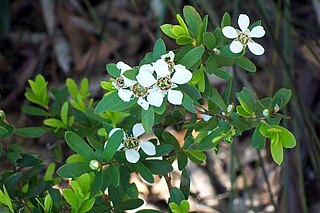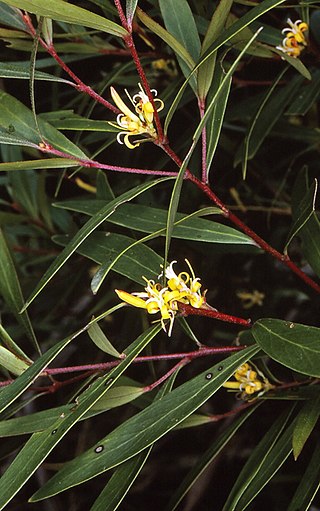
Leptospermum petersonii, commonly known as lemon-scented teatree, is a species of shrub or small tree that is endemic to eastern Australia. It has thin, fibrous or flaky bark, often strongly-scented elliptic to lance-shaped leaves, white flowers and fruit that are retained for several years. It is commonly grown as an ornamental and is regarded as a minor environmental weed in some areas.

Olearia algida, the alpine daisy-bush is a species of flowering plant in the family Asteraceae and is endemic to south-eastern Australia. It is a shrub with small, crowded, elliptic to narrow egg-shaped leaves with the narrower end towards the base and heads of white and cream-coloured, daisy-like flowers.

The Leptospermum grandifolium, commonly known as mountain tea-tree or woolly teatree, is a species of shrub or small tree that is endemic to south-eastern Australia. It has elliptical to egg-shaped leaves with a sharp point on the tip, white flowers and relatively large, broadly hemispherical fruit.

Leptospermum myrsinoides, commonly known as the heath tea-tree or silky tea-tree, is a species of shrub that is endemic to south-eastern continental Australia. It has smooth bark on the younger stems, narrow egg-shaped leaves with the narrower end towards the base, white flowers and fruit that has the remains of the sepals attached but usually falls from the plant soon after the seeds are released.

Leptospermum jingera, commonly known as the stringybark tea-tree, is a species of shrub that is endemic to Victoria, Australia. It has papery bark on the larger branches, smooth bark on the younger stems, narrow egg-shaped to elliptical leaves, white flowers and silky-hairy, hemispherical fruit.

Persoonia silvatica, commonly known as the forest geebung, is a plant in the family Proteaceae and is endemic to south-eastern Australia. It is a shrub or tree with more or less lance-shaped leaves and small groups of yellow flowers with white centres. It grows mainly in forest near the border between New South Wales and Victoria.

Leptospermum spectabile is a species of shrub that is endemic to a small area of New South Wales. It has thin bark, narrow elliptic leaves, dark red flowers arranged singly on short side shoots and relatively large fruit.

Leptospermum deuense is a species of shrub that is endemic to New South Wales. It is a leafy, densely branched shrub with rough bark on the older stems, elliptical leaves with a glossy upper surface, white flowers arranged singly or in pairs and woody fruit.

Leptospermum obovatum, commonly known as river teatree, is a species of shrub that is endemic to south-eastern continental Australia. It has egg-shaped or lance-shaped leaves that are narrower at the base, white flowers usually arranged singly on short side shoots and fruit that remains on the plant until it dies.

Leptospermum fastigiatum is a shrub that is endemic to the south-west of Australia. It has narrow egg-shaped leaves with the narrower end towards the base and a small point on the tip, white flowers arranged singly or in pairs on short side shoots and small fruit that fall off when mature.
Leptospermum subtenue is a species of small shrub in the family Myrtaceae and is endemic to Western Australia. It has thick, elliptical, concave leaves, white or pink flowers and fruit that falls from the plant when mature. It occurs to the south of Kalgoorlie.

Leptospermum coriaceum, commonly known as green tea-tree or mallee teatree, is a shrub species that is endemic to south-eastern Australia. It has smooth bark on the younger stems, elliptic to narrow egg-shaped leaves, white flowers and woody fruit. The usual habitat is mallee on sand dunes.

Leptospermum multicaule, commonly known as the silver tea-tree, is a species of shrub that is endemic to south eastern Australia. It has linear, narrow elliptical or narrow egg-shaped leaves, white or pink flowers usually borne singly on short side shoots, and fruit the falls from the plant soon after the seeds are released.

Leptospermum argenteum, commonly known as the Mt Royal tea-tree, is a species of shrub that is endemic to the higher parts of Barrington Tops in New South Wales. It has smooth bark, stems with a flange along the sides, broad leaves, white flowers and unlike many others in the genus, it is never lemon-scented.

Leptospermum benwellii is a species of shrub that is endemic to the Nymboida National Park in New South Wales. It has smooth bark, young branches with conspicuous flanges, narrow elliptical leaves, white flowers and thin-walled, bell-shaped to hemispherical fruit.

Leptospermum brevipes, commonly known as the slender tea-tree, is a species of shrub or small tree that is endemic to eastern Australia. It has fibrous bark on the main stems, smooth bark on young stems, narrow elliptical to narrow egg-shaped leaves, white flowers and hemispherical fruit that is shed when mature.

Leptospermum novae-angliae is a species of shrub that is endemic to eastern Australia. It has elliptical leaves that are usually crowded, single white flowers on short shoots and fruit that remain on the plant until it dies. It usually grows in rocky places.

Leptospermum subglabratum is a species of open shrub that is endemic to a south-eastern New South Wales. It has thin, rough bark, egg-shaped to lance-shaped leaves with the narrower end towards the base, white flowers arranged singly on short side shoots and relatively small fruit that falls from the plant at maturity.

Pultenaea reflexifolia, commonly known as wombat bush-pea, is a species of flowering plant in the family Fabaceae and is endemic to isolated parts of Victoria. It is an erect shrub with its foliage covered with tangled hairs, and has elliptic to narrow egg-shaped leaves with the narrower end towards the base, and yellow and red pea-like flowers arranged singly or in pairs on the ends of short side branches.
Pultenaea villifera is a species of flowering plant in the family Fabaceae and is endemic to two disjunct areas of Australia. It is an erect to prostrate shrub with triangular to linear, egg-shaped to elliptic leaves and yellow and red, pea-like flowers.


















